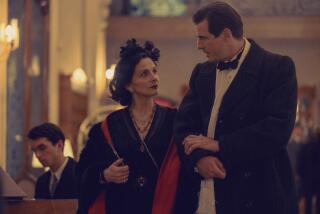‘AAAAA NAGEL IS A NAGEL’
- Share via
Art dealer Karl Bornstein looked into his wastebasket and knew in an instant that he had something.
“I found just the man I’d been looking for,” he says, “a cross between Roy Lichtenstein and Leonardo da Vinci.” The man was Patrick Nagel. He had stopped by Bornstein’s Hollywood office in 1974 to peddle the woodblock-inspired renderings he did when he wasn’t teaching drawing. The work that would soon become ubiquitous in beauty salon windows so underwhelmed Bornstein’s secretary that she tossed them as soon as Nagel left.
But in his trash Bornstein saw a promo sheet for an emerging market--young, not altogether upwardly mobile professionals who yearned for a better class of art than museum exhibition prints. Promising to make Nagel famous, he came up with a plan: Restrict supply by issuing only limited-edition series, then whip up demand through product placement. David Copperfield made a plane painted by Nagel disappear on a TV special. And the artist did a Duran Duran album cover as well as monthly illustrations for Playboy.
LeRoy Neiman, Playboy’s onetime artist-in-residence, is still a fan: “A Nagel is a Nagel. Often imitated but never replaced.”
As sales took off, Nagel earned his celebrity strokes with commissioned portraits of Whitney Houston and Joan Collins, who showed hers to Johnny Carson during a “Tonight Show” guest spot. UCLA’s Fredrick S. White Museum eventually displayed a one-man show of Nagel originals.
The limited editions, priced at about $35, spawned a new species of collector. They may not have known art, but they knew what they liked when they saw that it matched their faux-Deco furnishings. And it didn’t hurt that, say, a mauve and magenta model drawing (in a chrome or black lacquer frame) easily doubled as a coke-snorting surface in the drug’s heyday.
By the early ‘80s, with Nagels in an estimated 2 million homes worldwide, furniture designers were calling to find out which colors he’d be using next. Bornstein, now 53, says he even heard from a prominent plastic surgeon--one of Michael Jackson’s former doctors--eager to quiz Nagel about how he achieved his powerful shapes, simple lines and elements of classic beauty.
Before a show in New York City, the artist and the man who made him rich went shopping at Barneys New York in Manhattan. When a clerk recognized Nagel’s name on his American Express card and asked him for an autograph, Nagel turned to Bornstein and said, “You little SOB, you did it.”
On Feb. 4, 1984, after participating in a celebrity aerobics fund-raiser for the American Heart Assn. in Santa Monica, Patrick Nagel--out of shape from too many martinis and frozen Snickers--died of a heart attack. He was 38.
“He never thought of himself as a great artist,” Bornstein says, “as much as he did a really lucky guy.”
More to Read
The biggest entertainment stories
Get our big stories about Hollywood, film, television, music, arts, culture and more right in your inbox as soon as they publish.
You may occasionally receive promotional content from the Los Angeles Times.










